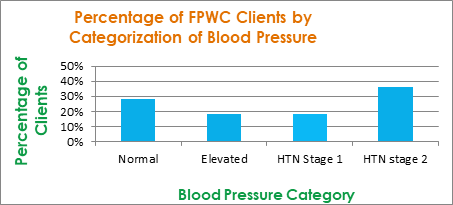March is National Nutrition Month
This guest blog post was written by Mount Mary University Dietetic Student Lisa Hillstrom
Hypertension in our Community
About 75 million American adults (29%) have high blood pressure—that’s 1 in every 3 American adults. Nearly half of those with high blood pressure do not have it under control, and 1 in 5 are unaware. In Wisconsin, roughly 10,000 adults are hospitalized for a heart attack per year and about 14,000 adults are hospitalized for a stroke every year. In a 2018 study conducted by Mount Mary University Dietetics students, 55% of The FOOD Pantry clients who participated in a blood pressure screening had readings consistent with high blood pressure. Of those, only 35% were aware they had high blood pressure. Fifty percent of those who screened with above normal readings had blood pressure levels consistent with stage 2 hypertension.
What is Hypertension?
Blood pressure is the force of blood pushing against the walls of your arteries. Hypertension refers to blood pressure with excessive (hyper) force on the arteries. Arteries carry blood from your heart to other parts of your body. Blood pressure normally rises and falls throughout the day. But if it stays high for a long time, it can damage your heart and lead to many different serious health problems such as congestive heart failure, kidney disease, stroke, and blindness.
High blood pressure is sometimes called the “silent killer” because it usually has no warning signs or symptoms, and many people do not know they have it. The only way to know if you have it is to measure your blood pressure. That’s why it’s important to get your blood pressure checked regularly. Then you can take steps to control it if it is too high.
Managing Your Blood Pressure
If you have high blood pressure, you and your health care provider need to work together as a team to reduce it. Your doctor will likely take two to three blood pressure readings each at three or more separate appointments before diagnosing you with high blood pressure. This is because blood pressure normally varies throughout the day, and it may be elevated during visits to the doctor (what they call “white coat hypertension”). Blood pressure is usually measured in millimeters of mercury (mmHg) and is recorded as two numbers—systolic pressure (as the heart beats) “over” diastolic pressure (as the heart relaxes between beats)—for example, 130/80 mmHg.
A blood pressure level of 140/90 mmHg or higher is considered high. About two-thirds of people over age 65 have high blood pressure. If your blood pressure is between 120/80 mmHg and 139/89 mmHg, then you have pre-hypertension. This means that you don’t have high blood pressure now but are likely to develop it in the future. Fortunately, you can control your blood pressure to lower your risk for serious health problems.
People who do not have high blood pressure at age 55 face a 90 percent chance of developing it during their lifetimes. So high blood pressure is a condition that most people will have at some point in their lives. Both numbers in a blood pressure test are important, but for people who are age 50 or older, systolic pressure gives the most accurate diagnosis of high blood pressure. Systolic pressure is the top number in a blood pressure reading. It is high if it is 140 mmHg or above.
| Blood Pressure Category |
Systolic (upper #) |
Dyastolic (lower #) |
|
|---|---|---|---|
|
Low blood pressure (hypotension) |
less than 80 |
or |
less than 60 |
|
Normal |
80-120 |
and |
60-80 |
|
Pre-hypertension |
120-139 |
or |
80-89 |
|
High blood Pressure (hypertension stage 1) |
140-159 |
or |
90-100 |
|
High blood pressure (Hypertension stage 2) |
160 or higher |
or |
100 or higher |
|
High blood pressure crisis (seek emergency care) |
higher than 180 |
or |
higher than 110 |
In Part 2 of our series, we will examine the risk factors and health consequences of hypertension. We also introduce you to the DASH (Dietary Approaches to Stop Hypertension) eating plan.
For more information, visit:
https://www.cdc.gov/bloodpressure/index.htm
https://www.nhlbi.nih.gov/health-topics/high-blood-pressure
https://www.eatright.org/health/wellness/heart-and-cardiovascular-health/dash-diet-reducing-hypertension-through-diet-and-lifestyle
https://dashdiet.org/default.html
https://www.nhlbi.nih.gov/health-topics/dash-eating-plan
https://sodiumbreakup.heart.org/salt-vs-sodium
https://www.nhlbi.nih.gov/files/docs/public/heart/hbp_low.pdf
https://www.nhlbi.nih.gov/files/docs/public/heart/hbp_low.pdf
https://www.nhlbi.nih.gov/files/docs/public/heart/dash_brief.pdf
Tags in this Post: Nutrition , Facts
Back to Blog
